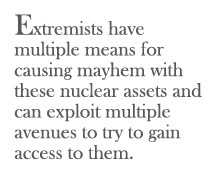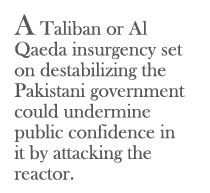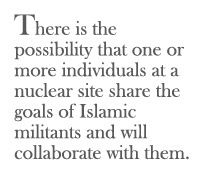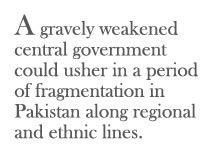Pakistan, Taliban and Global Security – Part I
Pakistan, Taliban and Global Security – Part I

WASHINGTON: As Afghan president Hamid Karzai and Pakistani president Asif Ali Zardari meet with President Barack Obama on quelling the threat from the Taliban and Al Qaeda, a sword of Damocles hangs over their summit: the danger that the Islamic extremist groups may gain control of some or all of Pakistan’s nuclear assets. The success or failure of the anti-Taliban operation currently underway in Pakistan could be the first indicator of the seriousness of the danger ahead.
Securing these assets is not simply a matter of locking away Pakistan’s 80 or so nuclear weapons; a much wider array of nuclear resources are potentially at risk. Moreover, extremists have multiple means for causing mayhem with these assets and can exploit multiple avenues to try to gain access to them.

Pakistan’s nuclear weapon production complex is spread over roughly a dozen sites, and many produce or process weapon-grade nuclear materials – highly enriched uranium and plutonium. Acquisition of these materials could enable Taliban or Al Qaeda technicians to assemble their own nuclear device. Highly enriched uranium is the more dangerous, since it can be made into a nuclear explosive using a much simpler design than required for a plutonium bomb.
Building a weapon could be made much easier if the extremists received assistance from sympathetic Pakistani nuclear weapon specialists or obtained a copy of the nuclear weapon design sold to Libya (and probably Iran) through the nuclear technology smuggling ring run by Pakistani nuclear scientist A. Q. Khan. Moreover, once it was known that extremists had gained possession of the weapon-grade material, these groups could credibly claim to have a nuclear device, since no one could be sure how far they had actually advanced towards this capability.
Plutonium presents an additional risk. Though more difficult to use for a nuclear explosive than high enriched uranium, it is much more radioactive and can be easily fabricated into a very dangerous “dirty bomb.” If detonated in a major Western city, for example, even though the bomb would not have a nuclear yield, it could cause panic and great economic loss by contaminating the detonation site with one of the world’s deadliest materials, one particle of which can cause lung cancer if inhaled.

The weapon-material production sites, themselves, present another set of potential targets. Judging from satellite images, for example, one Pakistani plutonium production reactor is situated within a sizeable city. A Taliban or Al Qaeda insurgency set on destabilizing the Pakistani government could undermine public confidence in it by attacking the reactor to cause the release of highly radioactive debris and trigger mass panic. Pakistan’s nuclear power plants, plutonium separation facilities, and radioactive waste storage sites could also be attacked to cause significant radioactive releases. What is more, any successful attack on the high-security nuclear-weapon-production complex could sow doubt as to the ability of the government to protect the nation’s most vital national security resource, substantially undermining its credibility.
Such attacks are not far-fetched. In August 2008, two Taliban suicide bombers killed at least 70 individuals at the gates of the Pakistan Ordnance Factory at Wah. The site is believed to be producing non-nuclear components for nuclear weapons, and, according to some reports, may be where Pakistan’s nuclear weapons are stored. Wah is less than 100 kilometers away from recent Taliban clashes with Pakistani government forces.
Transportation links used to move weapon-usable materials from production locations to weapon fabrication sites are additional points of potential vulnerability.

As for Pakistani nuclear weapons, they are thought to be stored in well fortified bunkers and kept with their nuclear cores separate from the non-nuclear components of the weapons. This arrangement would greatly complicate efforts to divert them by stealth or seize them by force. Nonetheless, there are many scenarios that even these relatively robust physical security measures cannot protect against.
The first is the “insider threat,” the possibility that one or more individuals at a nuclear site who share the goals of Islamic militants will collaborate with them, helping them to obtain sensitive materials or facilitate armed takeovers of nuclear sites by deactivating alarms or sharing security plan vulnerabilities. Pakistani officials claim to have purged protective forces of pro-Islamist elements, but the growing support for this ideology within Pakistan leaves doubts about the effectiveness of such measures.
The organized Islamist insurgency is a more daunting challenge. The Pakistani Army is now confronting the Taliban in the Swat Valley, with the outcome uncertain. If the Taliban can defeat the central government – many of whose troops are said to sympathize with the insurgents – and can retain a permanent foothold here, Taliban fighters will surely be emboldened to probe into government-controlled areas closer to the capital and to several key nuclear sites. Given their enormous political and military salience, the nuclear sites would be particularly appealing targets. Whether government forces would fare any better in protecting these locations than in the Swat Valley would be hard to predict. If a site were overrun, local physical protection measures would mean little.

More troubling than loss of individual nuclear sites to the Taliban or Al Qaeda is the possibility that their continued military gains, coupled with the groups' intensification of suicide bombings and future attacks on nuclear or other high-value targets, could enable the militants to topple the country's civilian government and take charge in Islamabad. Most observers consider this highly unlikely. Nonetheless, a gravely weakened central government could usher in a period of fragmentation in Pakistan along regional and ethnic lines - and with it possibly divided or uncertain control over the country's nuclear holdings. Intervention by the military would be another possible outcome. But even that historically strong institution may be fracturing, with some officers and elements of the Inter-Service Intelligence directorate, championing an Islamist, pro-Taliban, anti-Western posture. If this faction gained the upper hand and seized power, Pakistan could be transformed from a friendly nuclear-armed state to a hostile one overnight.
The Obama Administration is struggling to address these varied challenges. Its first objective, the central theme of Obama’s talks with Karzai and Zardari, is to build a consolidated effort to defeat the Taliban and its Al Qaeda allies. The increase in U.S. forces in Afghanistan and the current Pakistan government offensive in the Swat Valley are promising initiatives, even if their ultimate impact remains uncertain.
A second prong of U.S. strategy is Washington’s pledge to provide substantially increased economic aid to Pakistan to support new infrastructure projects and educational reform, in an effort to counter the appeal of the Islamists’ anti-Western teachings. Unfortunately, it could take a decade or more for this effort to produce results.
The United States has also actively supported Pakistani efforts to improve security over its nuclear enterprise. These efforts appear to have made considerable progress in recent years, but with Pakistani nuclear capabilities expanding – its third plutonium production reactor is now under construction – sustaining this progress will only grow more difficult. Moreover, any improvements to date could be overwhelmed by insurgent military gains or political collapse in Islamabad.
Thus, for those hoping to reduce nuclear risk within Pakistan, much rides on the government’s success on the battlefield. Its defeat in the Swat Valley could portend very dangerous times ahead.
Leonard Spector is Deputy Director of the Monterey Institute’s James Martin Center for Nonproliferation Studies and heads its Washington, DC, office.